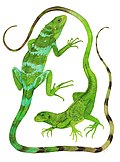Galapagos land iguana
| Galápagos land iguana | |
|---|---|

| |
| Scientific classification | |
| Domain: | Eukaryota |
| Kingdom: | Animalia |
| Phylum: | Chordata |
| Class: | Reptilia |
| Order: | Squamata |
| Suborder: | Iguania |
| Family: | Iguanidae |
| Genus: | Conolophus |
| Species: | C. subcristatus
|
| Binomial name | |
| Conolophus subcristatus (Gray, 1831)
| |
The Galápagos land iguana (Conolophus subcristatus) is a very large species of lizard in the family Iguanidae. It is one of three species of the genus Conolophus. It is endemic to the Galápagos Islands, in the dry lowlands of the islands of Fernandina, Isabela, Santa Cruz, North Seymour, Baltra, and South Plaza.[1][3][4]
Taxonomy
The land iguanas in the Galápagos vary in
Its specific name subcristatus is derived from the Latin words sub meaning "lesser" and cristatus meaning "crested", and refers to the low crest of spines along the animal's back, which is not as tall as in most iguanas.
Anatomy and morphology
Charles Darwin described the Galápagos land iguana as "ugly animals, of a yellowish orange beneath, and of a brownish-red colour above: from their low facial angle they have a singularly stupid appearance."[11] The Galápagos land iguana is one of the largest lizards in the world[12] growing to a length of 0.9 to 1.5 m (3–5 ft) with a body weight of up to 13 kg (29 lb), depending upon which island they are from.[13][14] Being cold-blooded, they absorb heat from the sun by basking on volcanic rock, and at night sleep in burrows to conserve their body heat.[13] These iguanas also enjoy a symbiotic relationship with birds; the birds remove parasites and ticks, providing relief to the iguanas and food for the birds.[3][15]
Diet and longevity

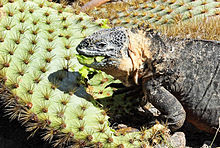
Land iguanas are primarily
The Galápagos land iguana has a 60 to 69 year lifespan.[3][14]
Reproduction
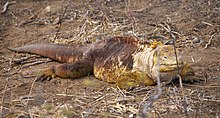
Galápagos land iguanas become sexually mature anywhere between eight and fifteen years of age, depending on which island they are from.[3] Mating season also varies between islands, but soon after mating, the females migrate to sandy areas to nest, laying 2–20 eggs in a burrow about 50 cm (20 in) deep.[3] The eggs hatch anywhere from 90 to 125 days later.[3][14]
On South Plaza Island, where the territories of marine iguanas and land iguanas overlap, the two sometimes interbreed, resulting in a hybrid iguana that shows a mixture of features from each species.[3] The most likely unions tend to be between male marine iguanas and female land iguanas. Despite their long separation time and their being two distinct species from different genera, the offspring are viable, although likely sterile.[3][5]
Population
It is estimated that between 5,000 and 10,000 land iguanas are found in the Galápagos Islands.[3] These iguanas were so abundant on Santiago Island at one time that naturalist Charles Darwin remarked when it was called King James Island that "...when we were left at James, we could not for some time find a spot free from their burrows on which to pitch our single tent".[13][16] In the years since then, entire populations (including all the animals on Santiago Island) have been wiped out by introduced feral animals such as pigs, rats, cats, and dogs.[3][13]
Evolutionary history
Researchers theorize that Galápagos land iguanas and marine iguanas evolved from a common ancestor since arriving on the islands from South America, presumably by rafting.[17][18] The marine iguana diverged from the land iguana some 8 million years ago, which is older than any of the extant Galápagos islands.[19][7] It is therefore thought that the ancestral species inhabited parts of the volcanic archipelago that are now submerged. The two species remain mutually fertile in spite of being assigned to distinct genera, and they occasionally hybridize where their ranges overlap.
Recovery efforts
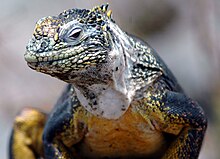
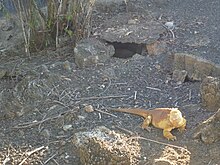

Beginning in the early 1990s, the Galápagos land iguana has been the subject of an active reintroduction campaign on
References
- ^ . Retrieved 17 November 2021.
- ^ "Appendices | CITES". cites.org. Retrieved 2022-01-14.
- ^ a b c d e f g h i j k l m n "Land iguanas" (PDF). Charles Darwin Research Station Fact Sheet. Charles Darwin Foundation for the Galapagos Islands. 2006. Archived from the original (PDF) on 2007-06-06. Retrieved 2007-10-14.
- ISBN 0-300-08864-7.
- ^ a b c d
Rassmann, Kornelia; Markmann, Melanie; Trillmich, Fritz; Tautz, Diethard (2004), "Tracing the Evolution of the Galapagos Iguanas", Iguanas: Biology and Conservation, California: University of California Press, pp. 71–83, ISBN 978-0-520-23854-1
- PMID 19124773.
- ^ a b "Explaining the Divergence of the Marine Iguana Subspecies on Espa". amnh.org.
- ^ a b Black, Richard (5 January 2009). "Pink iguana rewrites family tree". BBC News. BBC. Retrieved 20 May 2017.
- ^ PMID 19124773.
- PMID 26041359.
- ^
ISBN 978-0-14-043268-8
- ^ "The 10 Largest Lizards in The World". a-z-animals.com. 18 August 2021. Retrieved 12 February 2022.
- ^ a b c d e f
Rogers, Barbara (1990), Galapagos, New York: Mallard Press, p. 144, ISBN 978-0-7924-5192-1
- ^ a b c Rosenthal, Ellen (1997), "Days and nights of the iguana: in the Galapagos, a devoted pair work to save land iguanas", Animals
- ^ a b c
Kricher, John (2006), Galapagos: A Natural History, New Jersey: Princeton University Press, pp. 9, 51, 91, 200, ISBN 978-0-691-12633-3
- ^ Darwin, Charles (1839), Narrative of the surveying voyages of His Majesty's Ships Adventure and Beagle between the years 1826 and 1836, describing their examination of the southern shores of South America, and the Beagle's circumnavigation of the globe. Journal and remarks., London: Henry Colburn, p. 488
- S2CID 84822976.
- ^ Marine Iguana. marinebio.org.
- PMID 9126557. Retrieved 18 January 2023.


